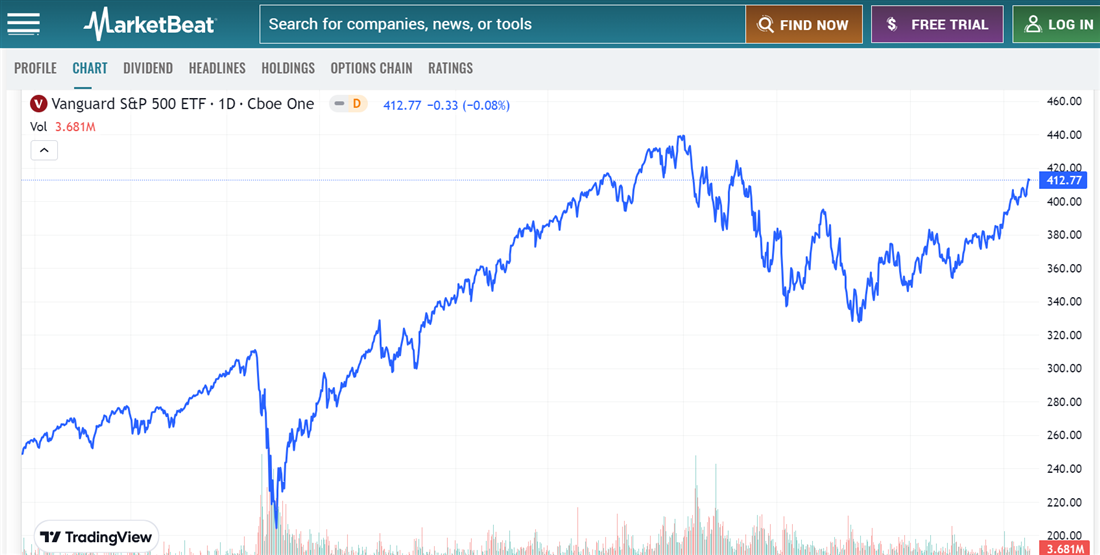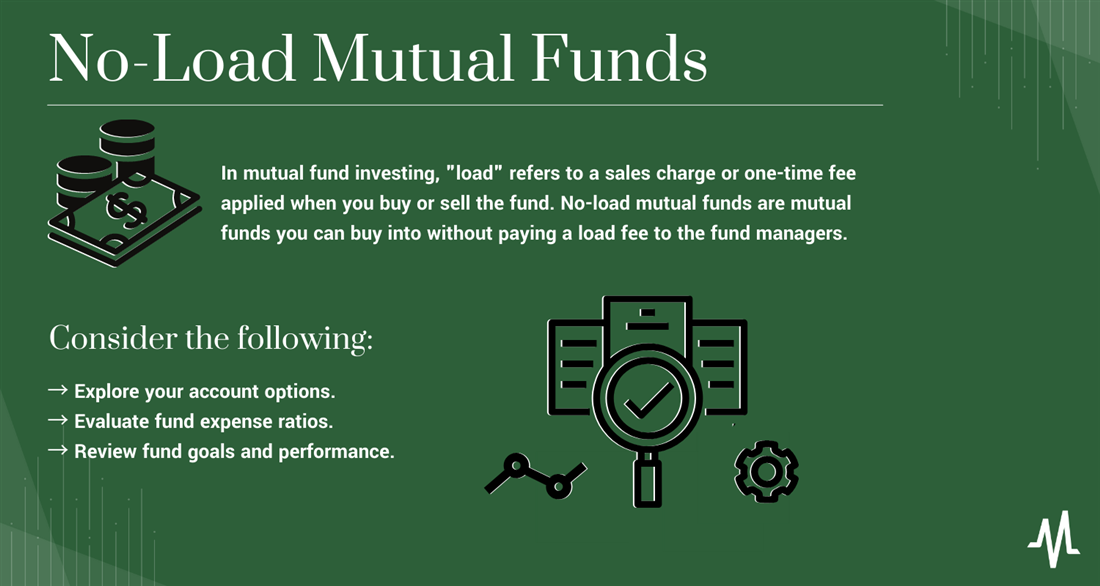No one wants to pay more than they need to in investment fees, especially on retirement funds. A no-load mutual fund can be an ideal addition to your investing account if you want to save on these fees. No-load mutual funds are mutual funds you can buy into without paying a load fee to the fund managers. While no load fund options don't come with a fee simply for purchasing or selling the fund, they earn money with other ongoing fees, including expense ratios.
Investors must pay special attention to operating expenses when buying no-load mutual funds, as these fees can impact overall return rates. But what are no load mutual funds, exactly, and where can you find these affordable options? Read on to learn more about how no-load mutual funds work and how you can identify a few of the best no-load mutual funds.
What is a No-Load Fund?
What is a no load mutual fund? Before discussing the difference between a no-load fund and mutual funds with loads, it's important to define the concept of a load. In mutual fund investing, "load" refers to a sales charge or one-time fee applied when you buy or sell the fund. In other words, when you purchase a mutual fund with a load, you'll pay a fee when you add the mutual fund to your portfolio.
Two major types of mutual funds include loads:
- Front-end load: Front-end load mutual fund options include a fee at the time of purchase. This fee is usually directly applied to your purchase amount and is deducted from the value of your buy order. This front-end load is usually calculated as a percentage. For example, a front load mutual fund might have a front-end load of 3%. If you place a buy order to purchase $5,000 worth of fund shares, 3% of this purchase value ($150) will go to the broker as the load fee. You would receive shares of the mutual fund equal to $4,850.
- Back-end load: Back-end loads are less common than front-end loads, but some specialized mutual funds still use this structure. Back-end load fees are levied when you sell your investment, with the fee deducted from the total value after the transaction. Some back-end loads have fees that reduce over time to incentivize you to hold the asset longer. For example, a back-end load might start with a fee of 3% that reduces by half of a percent each year you hold the fund.
You'll also notice many mutual funds advertised as "no-load mutual funds." As this name suggests, no-load mutual funds do not include a front-end or back-end load. When you place a buy order, you receive the full value of the order, and you'll also sell without deductions on the back end.
Overview of No-Load Funds
Most no-load mutual funds are structured as no load index funds. An index fund is a type of mutual fund or exchange-traded fund (ETF) that aims to replicate the performance of a specific market index, such as the S&P 500 or the Dow Jones Industrial Average. Fund managers select a basket of assets to mimic the performance of these indexes, allowing you to add a basket of securities to your portfolio with a single order. Index funds are a low-cost alternative to actively managed mutual funds, which may be rebalanced multiple times to outperform the market.
 Image: Vanguard offers index funds structured as both ETFs and no-load mutual funds — like the Vanguard S&P 500 ETF (NASDAQ: VOO) showcased above.
Image: Vanguard offers index funds structured as both ETFs and no-load mutual funds — like the Vanguard S&P 500 ETF (NASDAQ: VOO) showcased above.
No-load funds are popular among investors who prefer to manage their investments directly or who work with fee-only financial advisors. They offer flexibility and transparency since investors can enter or exit the fund without incurring additional costs. However, it's important to note that even though they don't have loads, these funds usually still have other expenses, including management fees and operating expenses. These fees must be disclosed in the fund's prospectus, which you should review before investing in any mutual fund.
How Much Do No-Load Mutual Funds Cost?
If a no-load fund doesn't charge a sales fee, how does the fund make money? Unfortunately, "no-load" does not mean "no fees." Some of the fees that you may find associated with no-load mutual funds include the following.
- Expense ratios: The expense ratio of a mutual fund is the annual operating expense you'll pay to hold the fund in your portfolio. Expense ratios are deducted from returns on your fund, usually taken from dividend payments throughout the year. No-load funds generally have lower expense ratios than load-bearing funds, but the exact ratio will depend on the specific fund.
- Management fees: These fees compensate the investment managers and their team for managing the fund's portfolio. The management fees are typically included in the expense ratio, but it's worth understanding the breakdown of these costs. Actively managed mutual funds have higher management fees than no-load index funds.
Review each mutual fund's prospectus to learn about expense ratios and any other fees you'll incur when investing.
Why Do Some Mutual Funds Have Loads?
While it might seem like mutual fund loads are just another fee fund managers are squeezing out of their clients, you might be surprised to learn that funds generally don't make money from loads. Loads are the sales charges paid to investment advisers or brokers who offer these funds to their clients. These are separate from the operating expenses of the fund, which are ongoing and need to be covered by the investor annually.
Some load-bearing funds offer additional advisory services to investors. The load helps cover the costs associated with providing personalized advice, portfolio management and ongoing monitoring by the financial advisor or investment professional. If you're considering investing in a load-bearing fund, investigate the fund's prospectus to learn more about what you're getting for your money. If you're comfortable conducting research and executing your trades, there is usually no compelling reason to opt for load-bearing funds.

How to Choose No-Load Mutual Funds
Now that you understand how no-load mutual funds work, compare fund options. You'll want to consider the following crucial characteristics when selecting which assets to add to your portfolio.
Step 1: Explore your account options.
The type of investment account you're using will play a role in the mutual funds available to add to your portfolio. Many investors purchase mutual funds through an employer-sponsored retirement account like a 401(k). The broker that services your employer's 401(k) accounts will individually select mutual funds available to investors, which will vary between brokers. Start by reviewing available funds — or by opening an independent retirement account like an IRA if your employer doesn't offer retirement benefits.
Step 2: Evaluate fund expense ratios.
After separating load-bearing mutual funds and no-load options, look at each fund's expense ratio. The expense ratio is a percentage related to the total assets you hold in the fund, meaning that the amount you pay is proportional to your holdings.
While expense ratios may only vary by a fraction of a percent between funds, differences could equal thousands of dollars when you withdraw your holdings in retirement.
For example, if a mutual fund has an expense ratio of 1%, you'll pay $10 for every $1,000 invested in the fund. By the time you reach $500,000 in assets as you make your way towards retirement, this would equal $5,000 in expenses annually. Pay attention to expense ratios, and select investments with reasonable expense ratios. For standard, passively managed index funds, expect an average expense ratio of around 0.2% annually.
Review each fund's goals after identifying a few funds with affordable expense ratios. Managers craft every mutual fund with a specific goal, whether sustained growth or income generation. Review the fund's goals and see how they align with recent performance before adding them to your portfolio to ensure you get the best no load mutual funds.
Should You Buy No-Load Mutual Funds Yourself or Through an Advisor?
Deciding whether to buy no-load mutual funds yourself or through an advisor depends on your circumstances and the amount of investing knowledge you have before placing your first buy order. Understanding mutual funds is easier than it might seem if you have no prior investing knowledge, and you don't need a degree in finance to identify affordable funds with goals that meet your needs. If you're willing to put in a bit of legwork and explore mutual fund options on your own, you can save a nice chunk of change by avoiding the load sales charge.
There are some circumstances when it can be worth buying mutual funds through an advisor — though these usually do include some load fees. Financial advisors are experienced professionals who can provide valuable expertise, including personalized advice and portfolio management services. If you value professional guidance, want assistance setting and achieving your financial goals or need help navigating complex investment strategies, working with an advisor might be worth the extra charge.
Explore Mutual Fund Investments
The Securities and Exchange Commission (SEC) is the government regulatory body that oversees mutual fund management, fees and sales throughout U.S. markets. According to SEC rules, all mutual funds must disclose the holdings that make up the fund's composition on an annual schedule — though most mutual funds make holdings openly available to investors at all times. You can find fund holdings by exploring the fund's prospectus, website or third-party fund resources like MarketBeat's catalog of major stock and ETF data.
FAQs
Pay attention to each mutual fund load fee on the options you're considering for your portfolio. The following are some last-minute questions you might have about stock and mutual fund investments.
Which is better, load or no-load mutual funds?
As a general rule, choosing no-load mutual funds over mutual funds with loads is often better, as they include an additional sales charge you'll need to cover. This sales fee does not go to the ongoing management of the fund, and instead is offered as a commission to the broker or financial advisor offering it. If you're willing to do some research, you can explore some great low-cost funds without paying an additional charge.
What is the disadvantage of a no-load fund?
No-load mutual funds usually don't provide investors personalized advice or guidance from financial advisors, which some investors are willing to pay for when selecting investments. When you opt for no-load funds, you'll need to be ready to put a little more time
How do no-load mutual funds make money?
The expense ratio is the primary source of income for no-load mutual funds, which represents the annual operating expenses as a percentage of the fund's average net assets. These expenses cover management fees, administrative costs and other operational expenses. No-load funds may also earn revenue through securities lending, lending securities from their portfolios in exchange for fees, and standard dividend distributions.
Before you make your next trade, you'll want to hear this.
MarketBeat keeps track of Wall Street's top-rated and best performing research analysts and the stocks they recommend to their clients on a daily basis.
Our team has identified the five stocks that top analysts are quietly whispering to their clients to buy now before the broader market catches on... and none of the big name stocks were on the list.
They believe these five stocks are the five best companies for investors to buy now...
See The Five Stocks Here
Enter your email address and we'll send you MarketBeat's guide to investing in 5G and which 5G stocks show the most promise.
Get This Free Report
Like this article? Share it with a colleague.
Link copied to clipboard.